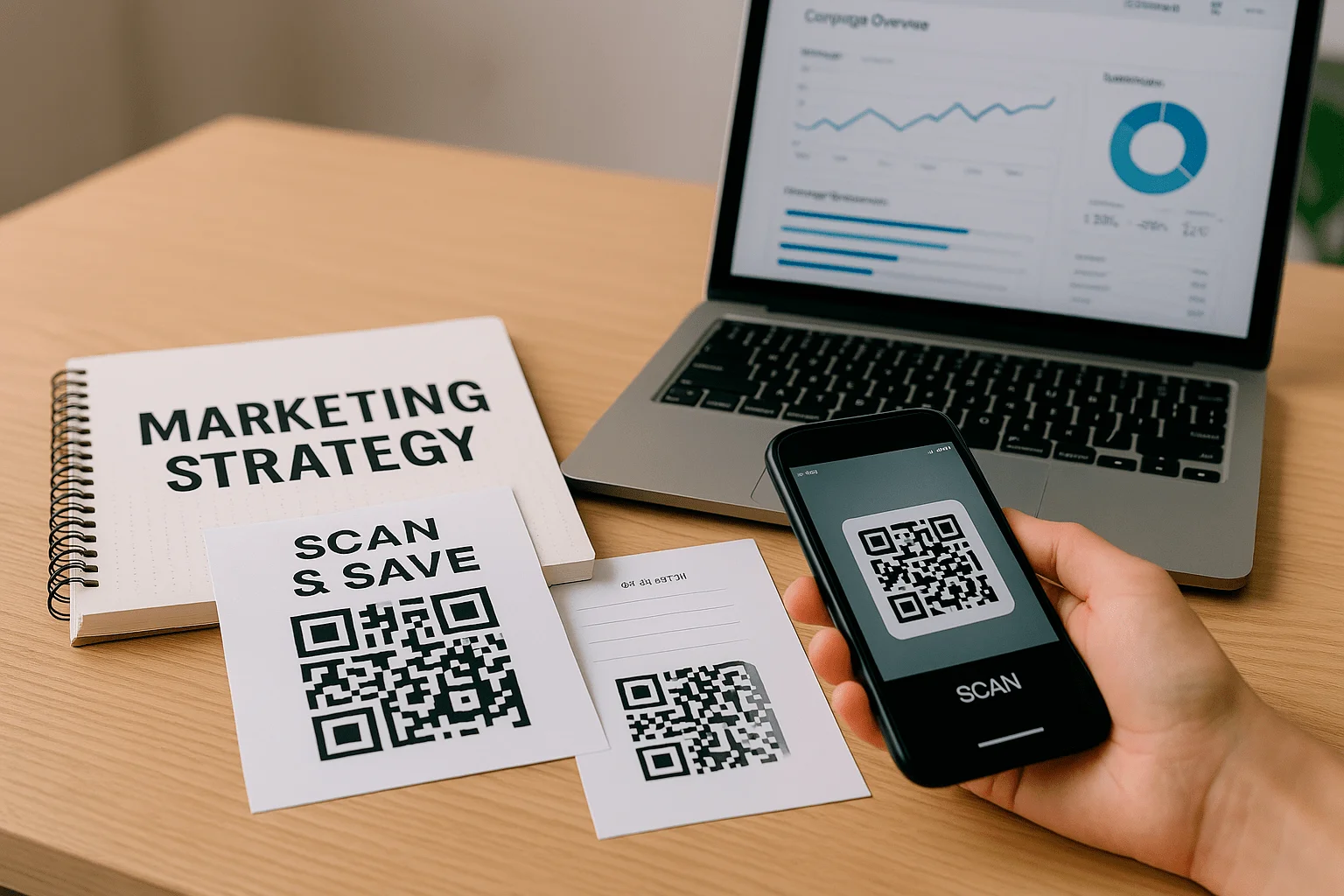
Marketing with QR codes: Tips for effective use
In today's digital marketing environment, businesses face a new challenge—how to shorten the customer's path to action without sacrificing the quality of communication. QR codes are the answer: they provide an instant bridge from physical interaction to digital content, maintaining control, analytics, and flexibility.
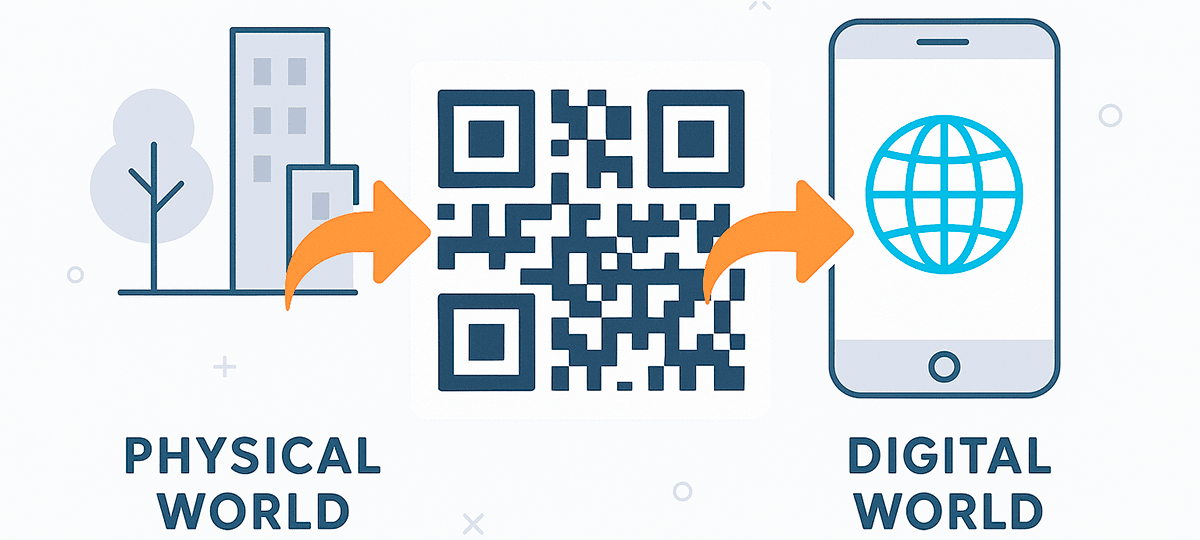
In this article, we'll explore QR code marketing strategies, discuss their advantages for engaging audiences, and explain how to create an effective QR code that delivers results. Special attention will be paid to scan analytics, branding, campaign placement examples, and mistakes to avoid.
This material is an in-depth analytical guide created to provide a deeper understanding of QR code marketing opportunities. Unlike basic overviews, we will explore integration strategies, omnichannel scenarios, performance analytics, and practical use cases for QR codes in business.
Why use QR codes in marketing?
QR codes in marketing campaigns are not just a convenience tool. They help shorten the customer's journey from interest to action, while providing analytical control, flexibility in configuration, and increased conversion rates.
They can be quickly integrated into any medium—print ads, packaging, POS materials, email marketing, or digital banners (examples of QR code usage in business). One scan—and the user is on a site, app, form, or social network (how to use QR codes in offline advertising). No mistakes, no manual URL entry.
Advantages of QR codes in marketing:
- Instant access to needed content: The user lands on the target page with no delay.
- Mobile-friendliness: Works on any smartphone without extra apps.
- Measurability: Every scan is tracked—marketers see the quantity, time, devices, and geography.
- Flexibility: You can change the destination for a dynamic code even after printing a flyer or poster.
- Integration with CRM, analytics, UTM-tags: Track conversions up to purchase or registration.
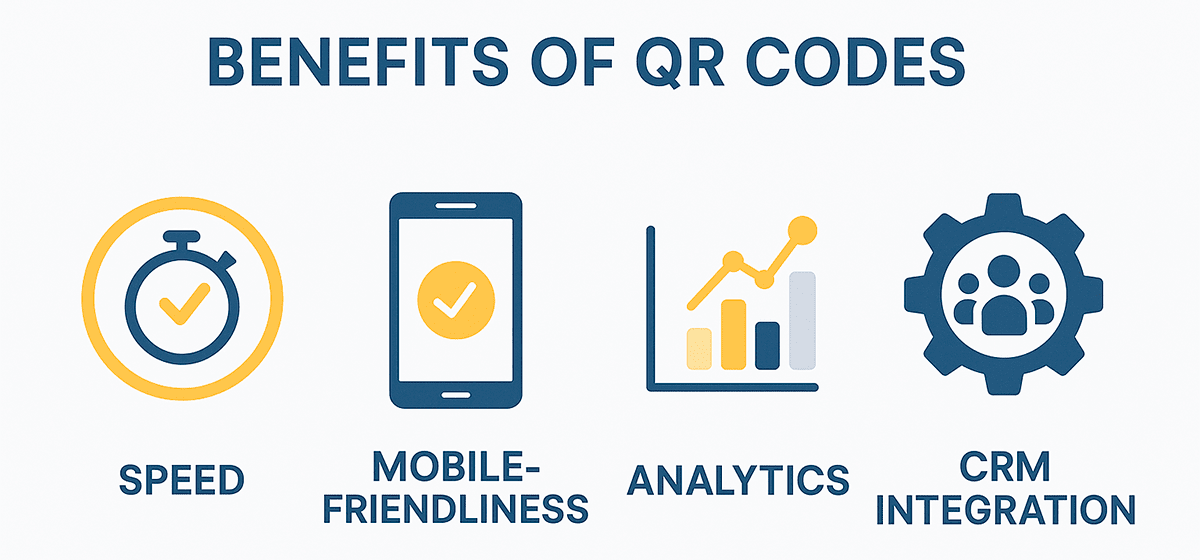
That's why more and more companies are integrating QR code marketing strategies into their daily campaigns—both in B2C and B2B.
Dynamic QR Codes for Business: Capabilities and Analytics
Most companies begin their acquaintance with QR codes through static ones—simple codes that lead to an unchangeable URL. However, for businesses looking to scale campaigns, optimize results, and make data-driven decisions, this functionality is not enough.
In this case, it makes sense to use dynamic QR codes—flexible, editable, and integrated into the company's analytics ecosystem. This is not just a technical alternative, but a fundamentally different level of managing user interaction.
What is a Dynamic QR Code and How Does It Work?
Unlike a static QR code, a dynamic QR code does not contain the final link in encrypted form. It leads to an intermediate redirect server, which then forwards the user to the actual landing page.
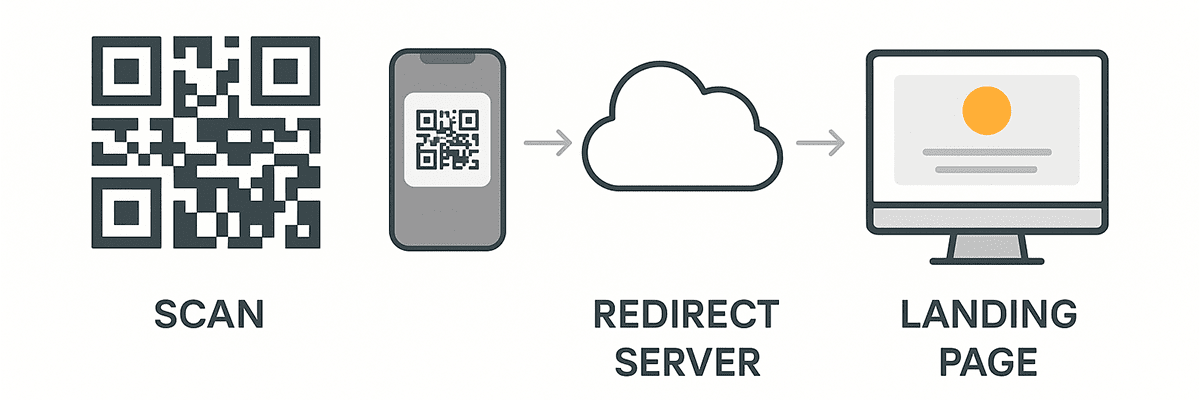
This allows you to change the final destination even after the code has already been printed or placed in advertising materials.
Key Benefits for Business
- Flexibility in management: you can update the target URL without reissuing the code—convenient for promotions, seasonal offer changes, or testing several content options.
- Access to real-time analytics: every scan is recorded, including parameters such as time, geography, device type, browser, language, and repeat scans.
- Ability to personalize the experience: via dynamic settings, you can implement geo-redirects, A/B testing, time or scan limits.
- Security and control: password protection, IP or time-based restrictions—critical for internal systems or restricted access (e.g., HR or logistics).
Examples of Practical Application
- Multi-stage marketing campaign: in phase A, the code leads to a presentation; in phase B, to a registration form; in phase C, to a discount. All stages are managed via the same QR code.
- Product packaging: the same code leads to different instructions depending on the browser language or user’s geolocation—no need to print multiple versions.
- Distribution control: you can see in which regions the product is actively scanned and plan campaign expansion according to audience behavior.
Dynamic QR Code Analytics: Turning Scans Into Insights
The main advantage of a dynamic code is the ability to connect analytics (learn more about QR campaign analytics). Combined with UTM tags, Google Analytics, or CRM systems, the QR code transforms from an access tool into a data collection point.

Typical metrics you can obtain:
- 📍 Total and unique scan count;
- 🌐 Geography (country, city);
- 📱 Device type (iOS/Android, mobile/tablet);
- ⏰ Time of interaction (peak hours, days of the week);
- 🔁 Interaction repeatability (new vs. returning users);
- 🎯 Conversion (when integrated with analytics or CRM).
In practice, this allows you to:
- ✔ Measure the effectiveness of different advertising channels (e.g., flyers, packaging, billboards);
- ✔ Make decisions about budgeting (keep the most effective channels);
- ✔ Build a full user funnel—from the first scan to purchase or registration;
- ✔ Segment the audience by behavior or region—and adapt offers accordingly.
QR Code as a Strategic Data Point
If you consider a QR code merely as "quick page access," you're underestimating its potential. In reality, it's an entry point to an analytical cycle: every scan is an event that can be measured, analyzed, and used for decision-making.
That's why dynamic QR codes today are not just a new format, but an infrastructure for integrating the physical environment with the digital. And for data-driven businesses, this means a new level of control over marketing, service, and sales.
How to Measure the Effectiveness of a QR Campaign: Metrics That Matter
Using QR codes in marketing is only half the job. The other, no less important part, is understanding how to measure the result. If a campaign lacks clear success metrics, it is hard to scale or justify spending. That is why you need a set of relevant metrics that let you assess how the code performs its role in the funnel.
QR Code is Not a Click, But a Behavioral Signal
Scanning a code is an active user behavior: they point the camera, focus, take an action. This takes more effort than a regular click in the digital environment. That's why it's important not to evaluate only by scan count, but to consider the full chain:
- 🧭 Scanning (number of interactions);
- 🌐 Page visit (registered in analytics);
- 📈 Behavior on the landing page (depth, time, events);
- 🎯 Conversion (purchase, application, subscription);
- 🔁 Repeat scans (loyalty, interest in the product).
Which Metrics Truly Matter?
- 📊 Unique scans
The number of distinct users who interacted with the code. This is the main metric to assess reach. - ⏱ Time and date of scans
Allows you to understand peak periods of activity, optimize the launch time of future campaigns. - 🌍 Geography
If the campaign covers several regions, it's important to see where users are most active. This can impact logistics, budgeting, and distribution. - 📱 Device and browser types
Knowing which platforms users scan the code from helps optimize landing pages better. - 📉 Drop-off rate
The ratio of scans to actual actions on the page. For example, if there were 1,000 scans and only 50 applications, it's a signal to review the content or offer. - 🎯 Conversion from QR traffic
This could be a subscription, purchase, or inquiry. Measured via target events in Google Analytics or CRM integration.
How to Connect QR Code with Web Analytics?
To not just count “clicks” but understand behavior, you should:
- ✔ Use UTM tags in dynamic codes;
- ✔ Connect goals in Google Analytics with events on the page after scanning;
- ✔ Integrate with CRM—to see who actually inquired/purchased.
💡 Tip: use separate QR codes for different channels (POS, packaging, flyers)—this will let you determine which brings the most conversions, not just coverage.
Quality Analytics is the Foundation for Scaling
If QR is used without collecting metrics, it works “blindly.” But as soon as you connect analysis, it's possible to:
- 🔁 adapt pages to user behavior;
- 💰 reallocate budgets to the most effective channels;
- 📥 prepare data-driven reports for management or clients;
- 🚀 launch experiments with content, design, CTA—and see the results.
Scanning is only the beginning. The true value of a QR code is revealed when it becomes part of the analytical cycle, forming the basis for your systematic marketing solution.
How to Integrate QR Codes into Advertising Campaigns
QR codes are a convenient tool, but their marketing value is fully revealed only when they become part of a systematic advertising campaign, not just an isolated element. For integration to be effective, it is crucial to understand not only “where” to place the QR code, but also “why”, “for whom”, and “what should happen after scanning”.
The Role of QR Codes in Advertising
Unlike traditional channels, a QR code transfers offline attention into online action — with no need to manually enter an address, search for the brand, or take extra steps. It provides a direct transition to a landing page or digital service.
For example: a user sees a flyer, scans a QR code, and lands on a page with a coupon, a video tutorial, or a feedback form. If this transition is logically embedded in the context, the chance for action increases significantly.

Key Placements for QR Codes in Advertising Campaigns
- 📦 Product packaging: turning every purchased product into a digital touchpoint. Codes direct to support pages, manuals, feedback forms, or “buy again” offers.
- 📰 Flyers, POS-materials, catalogs: one of the best ways to simplify the journey from information to action — without forcing users to memorize a website or search for a product manually.
- 🪧 Outdoor advertising (billboards, lightboxes, transport): combined with a concise call-to-action (“Scan to learn more”), the code becomes a conversion point, even if the ad is perceived in passing.
- 📩 Direct mail or magazines: when integrated into print materials, a QR code brings a second — digital — life to your message.
What to Consider When Integrating a QR Code into a Campaign
- 1. The context of the action after scanning: users need to understand what they will get. That’s why there should always be an explanation next to the code: “Get a coupon,” “Watch a video,” “Request a consultation”. This increases the number of scans and lowers the barrier to engagement.
- 2. Segmentation of carriers: use separate dynamic QR codes for each carrier (flyers, billboards, packaging) — this lets you compare their effectiveness in analytics. Track where users scan the most.
- 3. Clear user journey structure: scanning should lead to a page that matches the promise in the ad. Never simply send to the website homepage “in general.”
- 4. Code design as part of visual identity: if your campaign design follows the corporate style, but the QR code is a standard black-and-white one, it will be perceived as alien. Branded design helps attract attention and build trust.
Examples of Effective Integrations
- 🎁 Promo campaign with a gift: a code on a sticker with the product leads to a promo page with the order code. The user registers the purchase and receives a bonus.
- 🎥 Video review on a billboard: outdoor ad with a QR code leads to YouTube or TikTok with a real video demo of the product — especially effective in expensive or emotional categories.
- 📱 Scan to subscribe: code in a printed publication leads to a Telegram channel or Instagram page with updates or contests — easy engagement for mobile audiences.
- 🧾 Product instructions: instead of printing a long manual, the code leads to a mobile-adapted version — with video, PDF, or an interactive guide.
QR Code in the Marketing System: An Engagement Tool, Not Just an Add-On
The mistake in many campaigns is to add a QR code “just in case”, without connecting it to a specific action or outcome. As a result, there are few scans and even less benefit.
In contrast, when a code:
- ✔ is logically integrated into the structure of the advertising message,
- ✔ leads to an optimized and relevant page,
- ✔ has its own analytics and segmented identifier,
— it becomes a full-fledged acquisition channel that provides not only reach, but also measurable conversion. Most importantly — it allows you to react in real time: change the page, test offers, optimize placement.
QR Codes as Part of an Omnichannel Strategy
In the era of digital fragmentation, when users interact with brands across dozens of channels — from social media to physical touchpoints — the need for a unified, connected experience is growing. In this context, QR codes serve not just as access tools, but as a bridging element of an omnichannel strategy that ensures a seamless transition between offline and online.
QR Code as an Entry Point to Multichannel Engagement
A single QR code can launch a chain of personalized communications. For example:
- 📍 The user scans a code on packaging or in a flyer;
- 📲 Goes to a mobile page with a subscription or registration offer;
- 📧 Gets into an email flow or accesses a Telegram bot;
- 📊 Their actions are logged in the CRM and analytics system for further retargeting.
In this scenario, the QR code is a starting point, not the final action. With analytical integration and dynamic capabilities, brands can segment their audience, adapt content, and build full funnels without unnecessary barriers.
Typical Cases of Omnichannel Usage
- Offline → online subscription: a QR on a poster leads to a mobile form with UTM for personalized newsletter offers.
- Online → offline engagement: after registering, the user receives a QR code as a pass for an event or a store coupon.
- QR in the communication chain: after scanning, a CRM scenario is launched (lead → contact → remarketing via email/SMS).
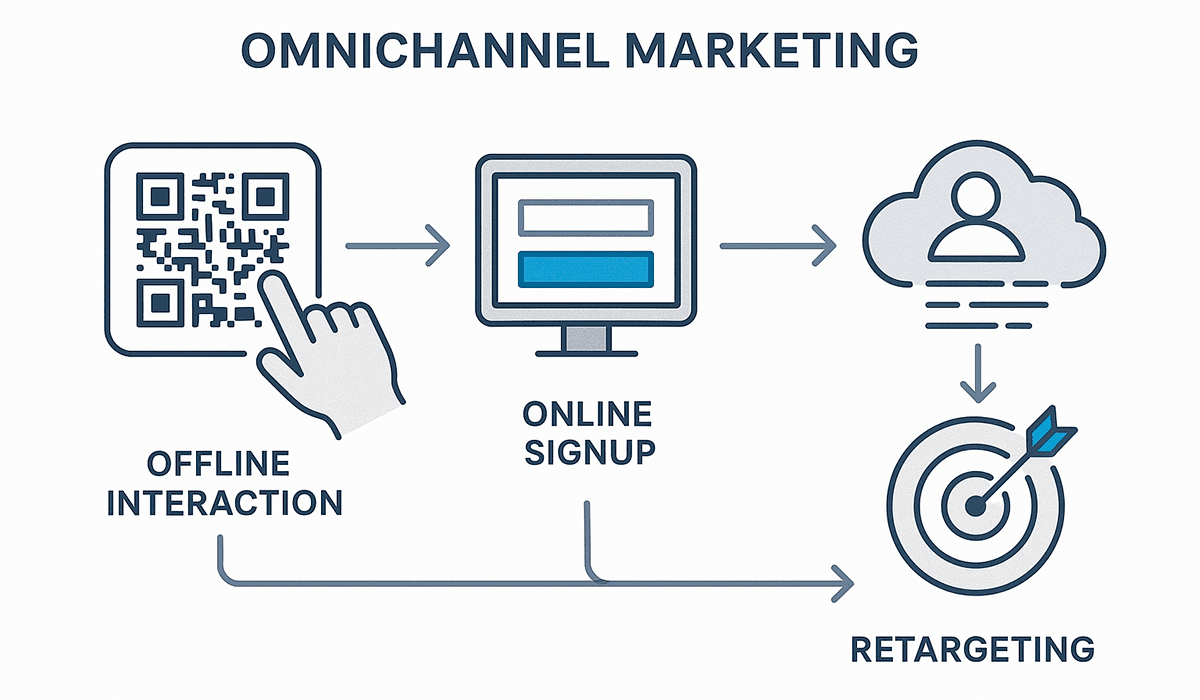
Why Are QR Codes Especially Effective in an Omnichannel Model?
- 🔄 They shorten the path between channels with no need to enter logins or addresses manually.
- 📌 They collect behavioral data at touchpoints that are usually difficult to measure (offline ads, events).
- 📡 They allow scaling communication — one code, multiple scenarios, personalization via redirects.
Combined with email marketing, messengers, CRM and analytics, QR codes become not just a supporting element, but a strategic integration point for channels. And this is exactly how they should be viewed in long-term marketing plans.
QR Code Design and Personalization: How to Strengthen Your Brand
Modern marketing is not just about functionality, but also about visual brand consistency. The design of QR codes is becoming a part of this strategy. A branded code with a logo, corporate colors, or an unconventional shape is scanned much more frequently (examples of branded QR codes) than a standard black-and-white one.
QR code personalization is a way to make even a technical element part of your visual identity. This affects not only aesthetics, but also user trust: a familiar style gives confidence that the code leads to a safe page.
What Can Be Customized in a Branded QR Code:
- 🎨 Corporate colors or gradients for the background and data points.
- 📐 Shape of corners and dots: circles, squares, custom figures.
- 🖼 Adding the brand logo to the center of the code with background removal.
- 🌀 Frames with captions or CTAs (Call To Action): “Scan to learn more”.
- 🔄 Templates — for quickly applying the same style across multiple campaigns.

In practice, QR code design for a brand affects the number of scans just as much as placement. If the code appears integrated into the advertising concept, it is perceived not as a "foreign element," but as a logical extension of the message.
💡 Tip: Add a short text near the code: “Get a discount”, “Watch the video” or “Register” — this can increase the number of scans by 2–3 times.
Personalization is not just about style. It's about trust, identity, and the desire to interact. That is why a branded QR code is an important detail in comprehensive marketing communication.
How to Create an Effective QR Code: Technical and UX Tips
A QR code is not just an image you can place on a flyer or label. To really work and contribute to marketing goals, you need to consider several technical, visual, and behavioral aspects. The effectiveness of a QR code is determined not only by where it leads, but by how easily, quickly, and seamlessly a user can interact with it.
In this section, we’ll look at the main rules for creating an effective QR code that combine UX design, ergonomics, and marketing appropriateness.
1. Contrast and Colors: Ensuring Scannability
A QR code must be highly contrasted against its background. This is a basic requirement that directly affects readability by smartphone cameras. The best combination is a dark code on a light background. Colored codes are also possible, but only if there is sufficient contrast.
Avoid light text on a dark background or codes with multiple similar shades — this can cause even modern devices to struggle with scanning.
2. Size: No Less Than 3×3 cm for Printed Materials
If the QR code is too small, it’s hard to scan. The minimum recommended size for printing is 30×30 mm (or 3×3 cm), but it’s better to use 4–5 cm, especially if the code is placed at a distance (e.g., in outdoor advertising or on a storefront).
For screens (banners, presentations, slides) — it’s important to account for scaling and the possibility to scan from different angles. Always test the code before publishing.
3. Logical Structure: A Simple User Journey
One of the key UX principles: the user should know what will happen after scanning. So it’s important to add a brief explanation near the code: “Scan to get the PDF”, “Learn more”, “Watch the video review here”. This lowers the interaction barrier and increases motivation to act.
Even better — use a CTA directly in the frame design (for example, in services like FbFast). This allows you to integrate text seamlessly into the layout.
4. Landing Page: Fast, Mobile, and Optimized
Equally important is where the code leads. If the page loads slowly, isn’t mobile-optimized, or requires extra steps (registration, confirmation, etc.), the user will simply close it. This is a loss of potential action.
Following a QR code is convenient only if the post-scan journey is just as simple. Recommended:
- ✔ Use lightweight landing or mobile pages.
- ✔ Add UTM tags for analytics in advance, but don’t shorten the URL too aggressively — some services get blocked by browsers.
- ✔ Test the page on iOS and Android, in Chrome and Safari.
5. Pre-Testing Before Printing or Launch
Before launching a print batch or advertising campaign, always check:
- 📱 Whether the code can be scanned from different devices and in various lighting conditions.
- 🌐 Whether the page works in a mobile browser.
- 🧪 Whether all content displays correctly (language, adaptation, behavioral elements).
6. Visual Prompt to Interact: The Role of CTA
Calls to action (CTAs) are not just about the text, but about the form of interaction. A frame with “Scan”, “Go”, “Watch video” or “Get a discount” is a powerful influence element.
Without a CTA, many people simply don’t understand what is expected after scanning. The result — low engagement, even if the code works technically.
💡 Tip: Always add a backup URL below the code (in shortened form). This allows users to visit the link manually if the camera does not work or the code cannot be scanned.
Creating an effective QR code is a combination of technical literacy, understanding user scenarios, and marketing logic. Even the best idea loses its point if implemented with errors. So — test, check, analyze, adapt.
Mobile Marketing and QR Codes: What You Should Consider
Modern marketing is unimaginable without the mobile context. Most interactions with QR codes today happen precisely via smartphones—users scan the code expecting to access content here and now. That’s why it’s important to view QR as part of your mobile marketing strategy, not just as a standalone tool.
The effectiveness of a QR code directly depends on how well you understand its usage scenarios on mobile devices. If, after scanning, the user lands on a “heavy” desktop page, can't find the necessary information, or is forced to take extra actions—the campaign loses its meaning.
1. Mobile Optimization—Not an Option, but a Requirement
After scanning, the code redirects the user to a browser. This means the page must:
- ✔ Be responsive and adapted to mobile screens.
- ✔ Load quickly—within 2 seconds—otherwise, the user will leave.
- ✔ Have a clear hierarchy: headline, call to action (CTA), minimal “noise.”
- ✔ Not require logins, CAPTCHAs, or unnecessary permissions (especially on the first interaction).
Use mobile landing pages, micro-pages, or integrations like Google Forms, Linktree, Facebook Lead Ads, creating QR codes for mobile apps—these are already optimized for smartphones.
2. Behavioral Patterns: What Users Expect
A person scanning a QR code expects to get results without delay. Therefore, the journey should be linear: without distracting elements, popups, or redirects.
If it’s a menu page—it should open immediately. If it’s a promo code—it shouldn’t have to be searched for at the bottom of the text. If it’s a form—it should be easy to fill in with one finger.
3. Mobile Analytics: What to Track After Scanning
Considering that over 90% of scans are mobile, you should integrate QR codes into web analytics systems:
- 🔹 Add UTM tags with a
device=mobileparameter or similar—for traffic segmentation. - 🔹 Track interaction time, scroll depth, and conversion specifically from mobile devices.
- 🔹 If the page contains video or interactive elements—check that they work correctly on both iOS and Android.
4. Where to Place QR Codes for Mobile Scanning
The success of QR communication often depends not only on which code you created but also on where you placed it. For mobile scenarios, the following work best:
- 📄 Flyers handed out “in person”—scanning happens immediately, without extra steps.
- 🛍 Product packaging or labels—the moment of interaction often occurs during unpacking.
- 🪧 Eye-level posters—too high or low placement makes scanning difficult.
- 📱 Screens/displays—if the code is shown during presentations or at POS, it should be large enough.
5. Do You Need a Mobile Site for Your QR Code?
Short answer: yes. In 2025, not having a mobile version of the landing page where your QR code leads is not just a technical shortcoming but a real threat to conversion.
Moreover, mobile adaptation is a ranking factor in search (especially for pages that are indexed). But even if the page isn’t public—a mobile version is critically important for UX.
If you don’t have the resources for a full mobile website—create a QR landing page in a service that lets you set up the structure without coding (for example, FbFast).
💡 Tip: Test not only the QR code itself but also the entire interaction flow on several smartphone models—iPhone SE, a mid-range Android, and budget models. This will help identify “bottlenecks” and improve accessibility.
QR codes are a mobile interface. This should be your view when creating, designing, placing, and analyzing them. Your task is to make this interface simple, convenient, and fast. That’s what true mobile marketing effectiveness is all about.
Examples of QR Code Usage in Business
One of the most effective ways to understand the potential of a technology is to see it in action. QR codes in business have long gone beyond the mere “go to website” function and have become a tool for analytics, conversions, automation, and enhancing the customer experience. In this section, we’ll look at practical scenarios where QR codes demonstrate maximum effectiveness.
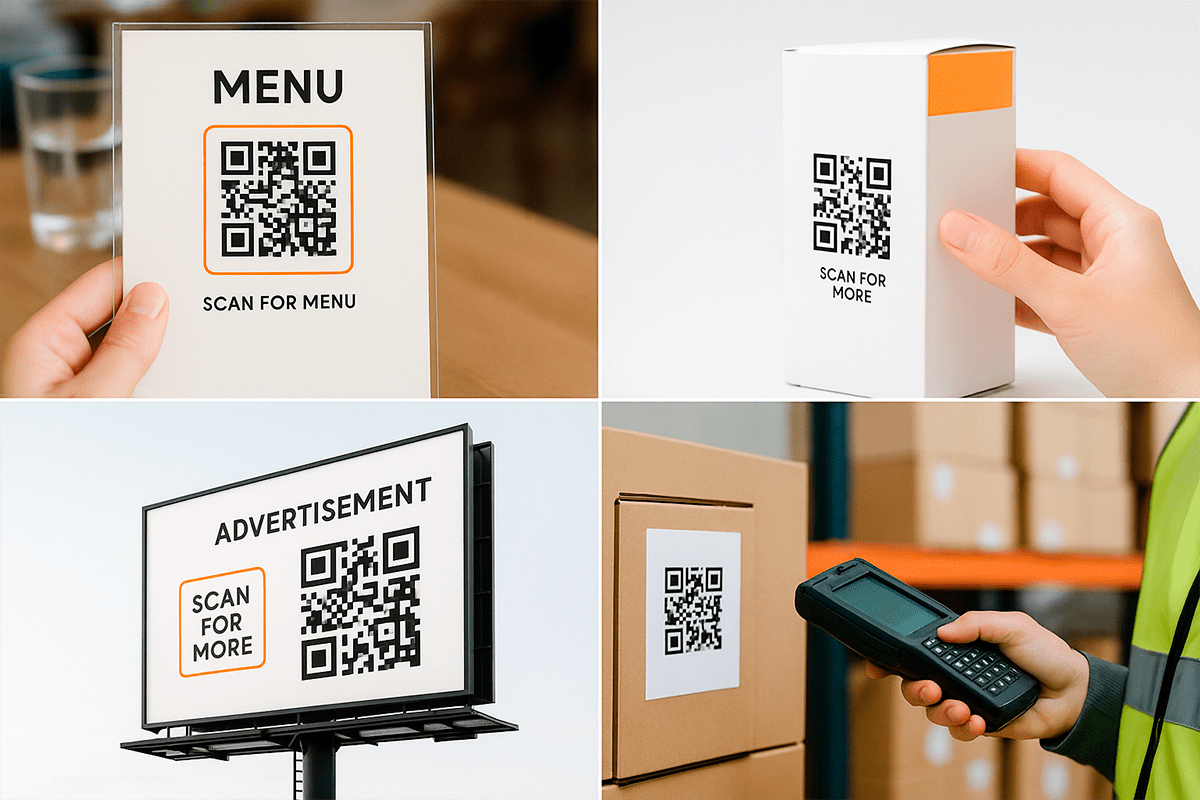
🛍 Retail and eCommerce
- QR on packaging: the customer scans the code and is redirected to the product page, video instruction, or feedback form. This not only informs but also lets you collect feedback at the moment the product is used.
- QR code at checkout: discounts or bonuses for scanning—a convenient mechanism for motivating repeat purchases without physical cards.
- Storefront with QR: even when the store is closed, users can scan the code and access the online catalog.
🍽 HoReCa — restaurants, cafes, hotels
- Menu via QR: clients scan a code on the table or counter and an adaptive online menu opens. This saves staff time and reduces contact points.
- Reservations: a QR code on a flyer or advertisement leads to a table, room, or delivery booking form.
- QR for feedback: after service, the client scans the code and leaves a rating or comment—without logging in or searching for the website.
📦 Logistics and Manufacturing
- Internal tracking: QR on a box or pallet links to a specification or routing sheet. Employees scan the code and receive accurate information without referring to paper documents.
- Technical documentation: instructions or checklists embedded in a QR code placed directly on the equipment.
- Quality control: each production stage is recorded by scanning a QR code—creating a transparent chain of responsibility.
📣 Marketing and Offline Advertising
- QR on billboards or transport: users scan while waiting—opening a promo page, TikTok, or video review.
- Promotions at events: raffles, participation, discount activation—all via a single code.
- Referral programs: each participant receives a personal QR code for sharing—with analytics and tracking of referred customers.
🎓 Education, Events, and Exhibitions
- Fast registration: scanning the code at the entrance instead of waiting in line at the desk or filling out paper forms.
- Event materials: QR on a presentation slide leads to a PDF or Google Slides, letting attendees save materials in a few clicks.
- Contact collection: attendees scan a code and a form opens to capture contact info or subscribe to a mailing list.
📊 Examples with Connected Analytics
- Advertising medium testing: a separate QR code for each placement type—analyzing what works better (POS vs flyer vs billboard).
- Demand geography analysis: analyzing scans by country/city—to better plan distribution or regional campaigns.
- Conversion funnels: using UTMs in dynamic codes allows tracking the path from offline ads to website purchase.
These examples show: a QR code is not a standalone element, but a part of a system. Its true value is revealed only when integrated with business processes, client interactions, and analytics. And most importantly—it's scalable: you can start with one scenario and gradually expand usage based on results.
Conclusions: How to Work with QR Codes Strategically
Using QR codes in marketing is no longer an innovation, but a standard that determines the convenience, speed, and effectiveness of communication between brand and consumer. However, real effectiveness starts only when the code is integrated into the overall campaign logic: from design and placement to scan analytics and mobile optimization.
If you treat this tool not formally, but as a full-fledged marketing link, it unlocks a range of benefits:
- 📈 the ability to measure offline interaction as accurately as digital;
- 🧩 creation of a seamless transition between print media and online activities;
- 🎯 real-time campaign adaptation via dynamic QR codes;
- 🤝 increased trust and brand recognition through design and personalization.
QR codes are not about technology, but about experience (the advantages of personalized QR codes for brands). About making the user journey from interest to action logical, fast, and comfortable. If this understanding is present in your business, QR codes turn from an additional “option” into a full-fledged growth tool.
If you are interested in a deeper technical breakdown of working with UTM tags, building analytics graphs, and optimizing QR campaigns, we recommend checking out the dedicated article “How to Track QR Code Effectiveness: Analytics, Graphs, UTM Tags”.